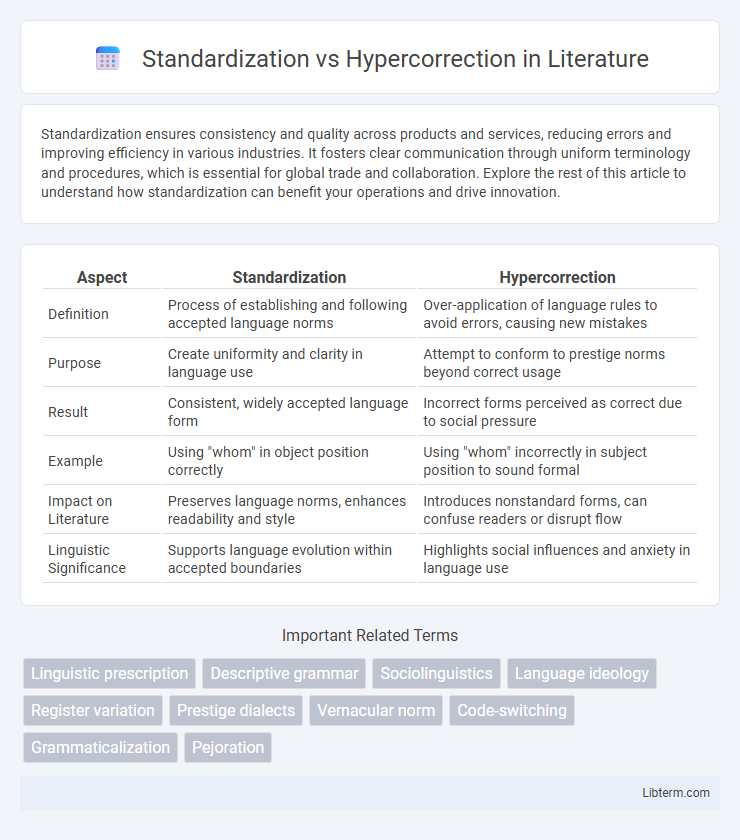Standardization ensures consistency and quality across products and services, reducing errors and improving efficiency in various industries. It fosters clear communication through uniform terminology and procedures, which is essential for global trade and collaboration. Explore the rest of this article to understand how standardization can benefit your operations and drive innovation.
Table of Comparison
| Aspect | Standardization | Hypercorrection |
|---|---|---|
| Definition | Process of establishing and following accepted language norms | Over-application of language rules to avoid errors, causing new mistakes |
| Purpose | Create uniformity and clarity in language use | Attempt to conform to prestige norms beyond correct usage |
| Result | Consistent, widely accepted language form | Incorrect forms perceived as correct due to social pressure |
| Example | Using "whom" in object position correctly | Using "whom" incorrectly in subject position to sound formal |
| Impact on Literature | Preserves language norms, enhances readability and style | Introduces nonstandard forms, can confuse readers or disrupt flow |
| Linguistic Significance | Supports language evolution within accepted boundaries | Highlights social influences and anxiety in language use |
Introduction to Language Standardization
Language standardization involves establishing consistent rules for grammar, spelling, and usage to promote clear communication across diverse speakers. Hypercorrection occurs when speakers overapply these standardized rules in inappropriate contexts, often as a result of social pressure to conform to prestige norms. Understanding the balance between natural language variation and prescribed standards is crucial for effective language teaching and policy development.
Defining Hypercorrection in Linguistics
Hypercorrection in linguistics refers to the application of perceived language rules beyond their standard usage, often resulting in non-standard or incorrect forms. It occurs when speakers overgeneralize prescriptive norms in an attempt to conform to standardized language, leading to errors such as incorrect verb conjugations or misplaced grammatical elements. This phenomenon contrasts with standardization, which involves the establishment and consistent use of accepted linguistic norms within a speech community.
Historical Background of Standardization
Standardization of language emerged during the 18th and 19th centuries, driven by printing technology and the rise of centralized education systems that established uniform grammatical rules and spelling conventions. This process aimed to create a common linguistic framework to facilitate communication, administration, and literature across diverse dialects and regions. Historical documents like Samuel Johnson's 1755 Dictionary played a crucial role in codifying English language standards, marking a pivotal moment in linguistic normalization.
Causes and Consequences of Hypercorrection
Hypercorrection occurs when speakers over-apply perceived rules of standard language, often due to insecurity about their speech or social pressure to conform to prestige norms, leading to nonstandard or incorrect forms. Causes include lack of complete understanding of grammatical rules and attempts to avoid stigmatized dialect features. Consequences of hypercorrection range from communication breakdowns to social judgment, as it may signal both a desire for social mobility and linguistic insecurity.
Key Differences Between Standardization and Hypercorrection
Standardization involves adopting widely accepted language rules and norms to ensure clear and consistent communication across different contexts. Hypercorrection occurs when speakers overapply perceived grammar rules, often leading to nonstandard or incorrect usage in an attempt to sound more proper. The key difference lies in standardization promoting linguistic accuracy and uniformity, while hypercorrection results in errors caused by excessive self-monitoring or misunderstanding of language conventions.
Impacts on Language Learners
Standardization provides language learners with consistent grammar, vocabulary, and pronunciation norms, facilitating clearer communication and smoother integration into global communities. Hypercorrection, often arising from learners' attempts to avoid perceived errors, can introduce nonstandard forms that hinder effective communication and cause confusion. The impact on language learners includes increased anxiety, reduced confidence, and potential setbacks in acquiring authentic language proficiency.
Standardization in Education and Media
Standardization in education and media ensures consistent language norms that facilitate clear communication and equitable learning opportunities. Educational curricula rely on standardized language to teach grammar, vocabulary, and writing skills, promoting uniformity across diverse student populations. Media outlets adopt standardized language conventions to maintain professionalism and accessibility, helping audiences easily understand and trust the information presented.
Hypercorrection in Everyday Communication
Hypercorrection in everyday communication often results from speakers' attempts to apply formal language rules incorrectly, leading to nonstandard usage that can confuse listeners. This phenomenon occurs when individuals overgeneralize language norms, such as misusing pronouns or verb forms, in an effort to sound more articulate or educated. Understanding hypercorrection helps linguists and educators recognize how language evolves and how social factors influence speech patterns beyond strict standardization.
Balancing Prescriptivism and Descriptivism
Standardization in language promotes uniform grammar and usage rules, ensuring clarity and mutual understanding across diverse speakers, while hypercorrection occurs when speakers over-apply prescriptive norms, often resulting in nonstandard or awkward forms. Balancing prescriptivism and descriptivism requires recognizing the value of linguistics description in capturing authentic language use, alongside maintaining standards that prevent miscommunication. Effective language policy embraces flexibility, encouraging adherence to conventions without stigmatizing natural linguistic variation or innovation.
The Future of Language Norms
Standardization in language promotes consistent grammar and vocabulary, ensuring clear communication across diverse regions and generations. Hypercorrection occurs when speakers overapply perceived rules, often leading to nonstandard forms that highlight social and linguistic tensions. The future of language norms will likely balance standardized practices with evolving usage patterns influenced by digital communication, social identity, and cultural exchange.
Standardization Infographic

 libterm.com
libterm.com